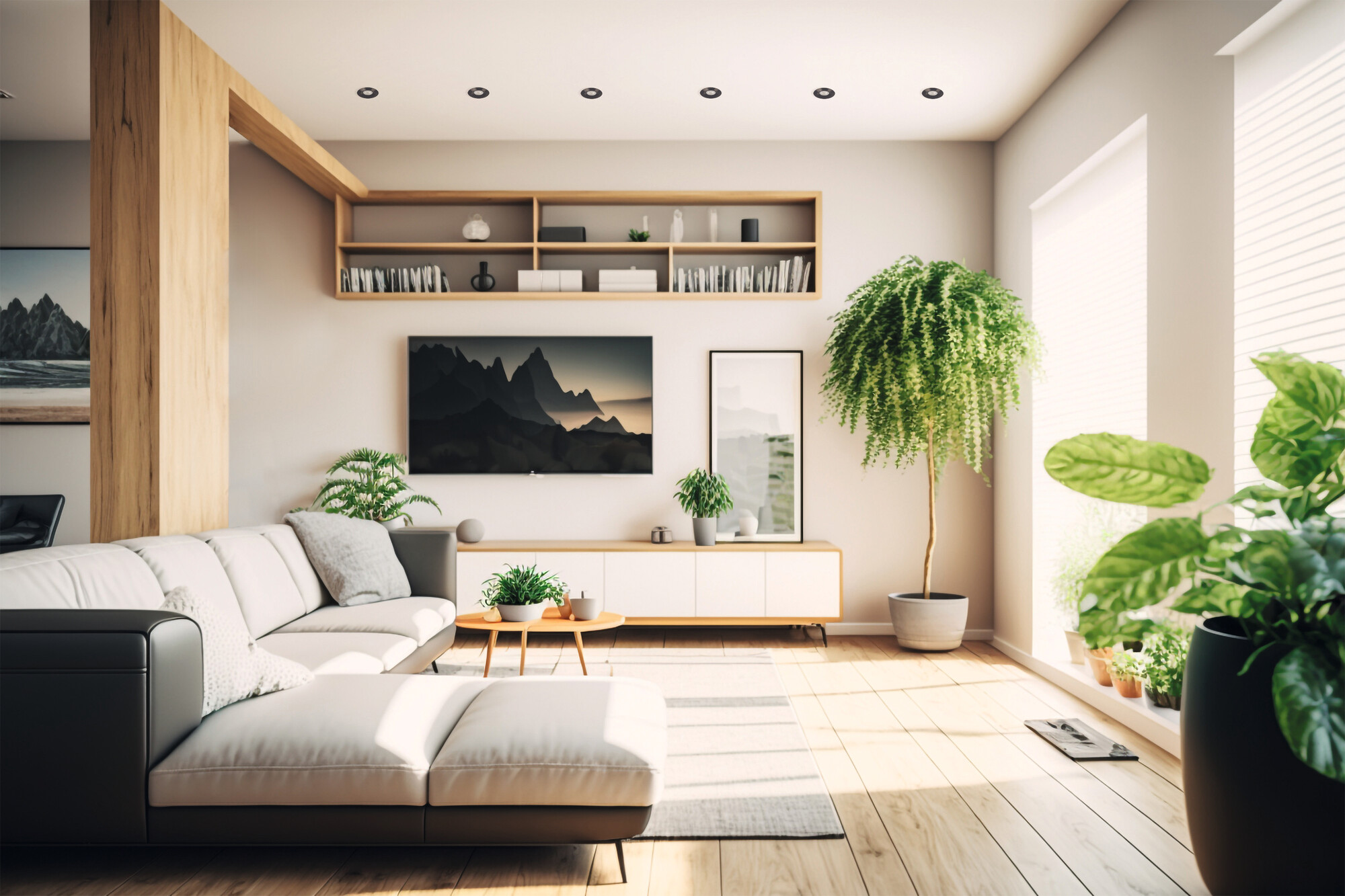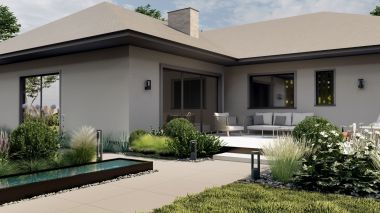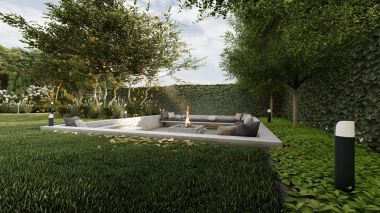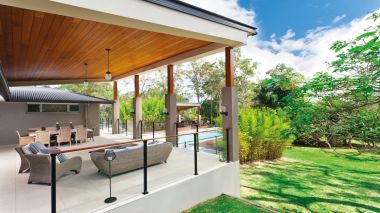Knowledge base
This is where it all becomes clear. You do not need to be a specialist in everything, it is important to know where to look for information. Therefore, in one place we gather useful tips for you, answer questions and provide a dictionary of terms.5 things to look out for when choosing lamps
Lighting plays a key role in interior design. The right light source can significantly impact the atmosphere and comfort of a space. So what should you consider when choosing lamps? Here are the 5 most important aspects to help you make the best choice.
Read more
Most Popular Articles
See all
How to create a special atmosphere in the garden with LED lighting?
The garden is a place where we spend more and more time. Spring and summer are conducive to relaxing...

Which lighting to choose for the barbecue area?
The right lighting around the barbecue area can make evening gatherings with friends even more enjoyable....

LEDs for the outdoors: garden and backyard lighting
LED lighting for the garden is a solution that combines efficiency, durability and a wide range of...
Dictionary of useful terms
- B
- C
- D
- E
- F
- G
- H
- I
- L
- M
- O
- R
- S
- T
- U
B
C
D
E
F
G
H
I
L
M
O
R
S
T
U
You want to find out something?

Ballast
a device working in an electrical circuit with discharge lamps, mainly used to stabilise the discharge current.
Brightness
physical equivalent of luminance; visual impression where the surface appears more or less bright (dark, vivid).
Cap (thread)
is the part of the bulb used to attach it to the casing, the type of cap and the corresponding casing is usually described in one or more letters and a number indicating the approximate size of the cap in millimetres (usually diameter or pin spacing), e.g: E27, E14, GU10. When you buy a new bulb, don't forget to check for which cap the lamp is adapted.
CE
CE marking on a product means that it meets all the requirements of the European Union directives and that it has been subjected to appropriate tests completed with a positive assessment.
Colour rendering index (Ra, CRI)
means the effect of lighting on the perceived colour of objects by comparison with their perceived colour under reference lighting. The higher the ratio, the better the colours are rendered and the more natural the objects are lit. Faithful colour presentation is particularly important in paint shops, showrooms, boutiques and dental practices. It is recommended to use fluorescent lamps with Ra greater than 90.
Colour temperature
the advantage of LED solutions is the ability to choose the colour of light (so called colour temperature expressed in Kelvins [K]). The colour temperature is matched to the place of application, and also according to our tastes. The choice between warm white (WW),
neutral white (NW)
and cool white (CW)
opens up new possibilities for creating an interior climate. In rooms such as living rooms and bedrooms, where we want to create a cosy atmosphere, we most often use a source of warm colour, in places where activity is intensified, such as kitchens, workshops or offices, a neutral colour similar to daylight will be ideal
Colour temperature Tc [K]
the advantage of LED solutions is the ability to select the light colour (the so-called colour temperature expressed in Kelvin [K]), corresponding to tastes and place of application. The choice between warm white (WW), neutral white (NW) and cool white (CW) opens up new possibilities for creating the interior climate. In rooms such as the living room or bedroom, where we want to create a cosy atmosphere, we will use a source of warm colour. In places of intense activity, such as kitchens, workshops or offices, a neutral colour temperature similar to daylight will be ideal.
Colour uniformity
indicates that there is no difference in the shades of light emitted by the same filament lamp from different production batches.
DALI
is a digital lighting control system, derived from English (Digital Addressable Lighting Interface). DALI allows you to control individual luminaires by using peripherals or a computer with an additional two-wire cable..
Dimmable
means that the value of the luminous flux can be adjusted by means of an external control device (dimmer). In order to be able to control the intensity of lighting in your home, you need luminaires and bulbs that are suitable for this purpose.
Downlight
a luminaire that focuses the light "from above". This type of lighting is very popular in offices and boutiques. They are mounted in the ceiling at several points. Rooms where downlight fittings are used become spacious and thanks to that its appearance become more sophisticated. Downlight luminaires are increasingly being installed in homes and flats.
Durability
generally speaking, it means the luminous duration in hours (under strictly defined conditions). One of the main features of LED sources is a very long service life, which should be an important factor in the choice of lighting. At home, with an average of three hours of operation per day per year, 25,000 hours is more than 20 years of operation without the need to replace sources with new ones.
EAC
The Certificate of Conformity of the Customs Union ensures that the products meet the requirements set out in the technical regulations of the Customs Union (it consists of, among others, Russia, Kazakhstan, Belarus).
Energy efficiency class
It determines the degree of energy efficiency of a given light source. The latest energy efficiency classes for lamps are marked with letters from A (most efficient devices) to G (least efficient devices).
The energy efficiency class of lamps is determined by their Energy Efficiency Index (EEI).
The energy efficiency class label on the lamp packaging allows you to easily compare the energy efficiency of different models.For example, an LED source that consumes 4W can give us 800 lumens of light (currently class A), another source that also consumes 4W will give us 250 lumens of light (class G). The higher the class, the more light from less energy the device will give us.
Thanks to the information on the energy efficiency class, customers can consciously choose products that consume less energy, are more environmentally friendly and allow you to save on electricity bills.
Fluorescent lamp (fluorescent tube)
a discharge lamp in which light is produced by excitation of a layer of phosphor by means of ultraviolet radiation produced during the discharge. This name is most often used to refer to a low-pressure mercury lamp, commonly known as a glow tube.
Glare effect
this is a state of discomfort or reduced ability to recognize objects as a result of too bright, blinding or tiring light in the field of vision. It may also be caused by an inappropriate distribution of luminance in time or space. The glare effect may be caused by excessively bright, poorly planned or poor quality light sources and other light-reflecting objects. Lighting can vary in severity, from temporary disturbance to temporary blindness. The glare effect can be eliminated or reduced by selecting suitable luminaires and planning lighting points in rooms.
Highlight lighting
means a type of lighting whose light flux is directed to a given location in order to light a selected object or part of a surface. The use of this type of lighting allows you to bring out all the advantages of our interior such as: decorations, paintings, sculptures or architectural details.
IK class
determines the mechanical impact strength. This allows you to determine the degree of protection provided by the housing against external mechanical impacts. The parameter is set on an 11-point scale ("00" - no protection to "10").
The higher the numerical value of the IK parameter, the greater the resistance potential, i.e. mechanical strength.
IK 01 mechanical strength is 0.15 J.
IK 02 mechanical strength is 0.2 J.
IK 03 mechanical strength is 0.35 J.
IK 04 mechanical strength is 0.50 J.
IK 05 mechanical strength is 0.70 J.
IK 06 mechanical strength is 1 J.
IK 07 mechanical strength is 2 J.
IK 08 mechanical strength is 5 J.
IK 09 mechanical strength is 10 J.
IK 10 mechanical strength is 20 J.
This parameter should be taken into consideration when choosing in-ground lighting fittings to be mounted on the driveway, between paving stones or outdoor fixtures, surrounding traffic routes where random people appear, as well as in places exposed to vandalism attacks.
Illumination
a term used to describe the artistic illumination of buildings with artificial light.
Incandescent lamp
an electric light source in which the glowing body is a highly heated current flowing fibre made of difficult-to-melt material (originally graphite, now tungsten). Tungsten wire is placed in a glass bulb filled with a mixture of noble gases (e.g. argon with a 10% nitrogen admixture) or a vacuum.
Incandescent lamp equivalent
approximate equivalent power value of a conventional incandescent lamp emitting the same luminous flux as the LED light source. It is given to facilitate the choice of replacement bulbs in the form of LED bulbs.
IP class
indicates the degree of protection of the equipment or electrical apparatus against external influences. The designation consists of IP letters and two to four characters, the first of which means resistance to the ingress of solids and the second to the ingress of water, e.g. IP54 - grade 5 means protection against the ingress of dust in quantities that interfere with the operation of the device, while grade 4 means protection against drops falling at any angle on all sides (e.g. rain). The higher the IP class, the more resistant the device is to water and solids ingress.
LED lamp
is a light source based on light emitting diodes, placed in a casing which allows them to be used in a luminaire designed for light bulbs. Commonly known as LED bulb, although in Polish these terms are not entirely correct - bulb is a source of light using a filament, i.e. wire of difficult-to-melt metal (currently tungsten). LED lamps (LED light sources) can have different shapes reminiscent of traditional bulbs, halogen spotlight fittings or fluorescent lamps.
Lifetime
an estimate of the period over which the guaranteed lighting parameters will be maintained. The service life is given in an hourly rate.
Light distribution angle (lighting angle)
determines how widely a light bulb shines on the surface where the light is actually effective. A narrower angle indicates a more focused light beam, directed at one place, and a wider angle is the light more scattered on the surface. Different angles of light are the areas that a bulb can light. If you want to light a uniformly selected room, but do not care about the high intensity of light, it is best to choose LEDs with a wide lighting angle from 120°, replacing the traditional bulbs with 40 and 60 W bulbs.
Light-emitting diode
a light emitting diode, more commonly known as an LED, is a direct conversion of electricity into light through the phenomenon of electroluminescence.
Louvre
special protection of light sources used in luminaires. Its task is to evenly illuminate the room and eliminate the effects of reflection and refraction.
Luminous efficiency
determines the efficiency of the lamp, namely the quotient of the emitted light output and the power consumed by the lamp (unit: lm/W). The more lumens a watt emits from a light source, the greater the light efficiency of the light source.
Luminous flux
determines the amount of light emitted by the light source. The unit of measure of the luminous flux is the lumen. More lumens means a light source that gives more light. LED sources already provide such high luminous fluxes, that they can easily replace all conventional incandescent bulbs, even the most powerful ones. When buying an LED it is worth paying special attention to the value of this parameter.
Luminous flux pulsation
high-frequency flickering of the light due to natural (i.e. undisturbed) variation of the alternating voltage that supplies the light source. The reason for the pulsation is insufficient inertia of the light production process in the lamp. The effect is not visible to the human eye because of its high frequency, but it is considered to be a nuisance, adversely affecting the mood. When choosing a light source, it is worth paying attention to the information concerning luminous flux pulsation, at reputable manufacturers, this effect is minimized or eliminated in order not to tire the eyes.
Luminous-flux-retention factor (LLMF)
means the ratio of the luminous flux emitted by a lamp at a given point in its life to its initial luminous flux.
Metal-halide lamp
a high-pressure discharge lamp in which light is produced by an electrical discharge in a mixture of mercury vapour, argon and metal halides (sometimes also other noble gases and bromine or iodine). These gases are under high pressure hence the term high-pressure lamp.
On/off cycle
means the sequence of switching the lamp on and off, it shall be tested to determine its potential durability.
Operating temperature
the temperature range within which the luminaire can operate.
Rated (nominal) power
determines the power consumed by the filament lamp when supplied with its rated voltage. The unit is WAT [W].
Rated value
means the value set for a given product under specified operating conditions, stating whether or not it is operating in accordance with the standards or recommendations of the manufacturer. Exceeding the rated value can cause malfunction, change of parameters or damage.
Reflector
a device in which the phenomenon of reflection is used to modify the spatial distribution of the luminous flux from the light source.
Replaceable light source / replaceable bulb
Determines the type of light source. In the non-replaceable version, the light source means that the lamps with LEDs are permanently integrated into the luminaire structure. The light source cannot be replaced after the lamp has worn out and stops working. Lamps with a replaceable light source have a different construction than a luminaire adapted to the specific thread. In this variant we have the freedom to choose the power and colour temperature of the light bulb. The bulb must be purchased separately in this variant.
Self-shielding lamp
the type of halogen lamp or metal halide lamp for which it is not necessary to use a protective screen against UV radiation or splashing of the lamp in the lighting fixture.
Spotlight
the type of luminaire is characterized by the concentration of light in a strictly defined area, usually with an angle of no more than 45 degrees. This type of luminaires is most often used in interior lighting to expose selected elements in a room.
Starter
is the common name for a fluorescent lamp starting switch.
Starter (starting switch)
a device for igniting the discharge lamps by heating the electrodes or by overvoltage in the circuit with the ballast.
Supply voltage
means the supply voltage specified by the manufacturer for a given light source (lamp, luminaire, etc.) in order for the device to function (light) correctly.
Thermal resistance (Rth)
the physical quantity representing the resistance that a given matter puts to the transfer of heat (thermal energy) between two points. It is important in electronic circuits (also in LED lamps), where heat dissipation is crucial to prevent overheating.
UGR
(English Unified Glare Rating) is a unified glare indicator, one of the methods of glare assessment recommended by the International Lighting Committee. The value of the indicator is calculated on the basis of appropriate measurements.
Frequently asked questions
What does LED mean?
LED stands for Light Emitting Diode.
Is it difficult to replace a traditional bulb or fluorescent lamp?
Replacing a traditional bulb with an LED bulb is not difficult. Anyone can replace it, but if you don't feel up to it, let's use the help of a professional (preferably an electrical installer or an electrician). The replacement is the same as when you replace a regular bulb or fluorescent lamp. Unscrew or remove the conventional bulb and in its place you screw in or insert an LED bulb in the same way. The LED bulb must have the same cap as the previous bulb. The only things you should pay attention to are the dimensions of the conventional bulb and the dimensions of the LED bulb, you can find them on the packaging or in the manual. When replacing bulbs remember to switch off the electrical system first.
Can I replace a fluorescent lamp with a tube fluorsecent LED light?
Direct replacement of fluorescent lamps with LED tubes is possible with luminaires equipped with magnetic ballast. Then, using a special replacement for the fluorescent lamp starter, it is possible to use an LED tube. Such replacements are relatively safe in systems where one ballast is used for the operation of one fluorescent lamp. With dual systems, LED sources may be unstable or operate without reaching the maximum declared luminous flux. There is also the possibility of converting the existing power supply system to power the LED tube, although any interference with the luminaire structure will void the manufacturer's warranty. Modification of the luminaire should be done by a qualified electrician with a relevant certificate of qualification. The simplest and safest solution is to replace the luminaire with one that is adapted to LED fluorescent lamps.
How does an LED produce white light?
LEDs are monochrome light sources, i.e. they emit light within a narrow range of visible light. It is therefore impossible to obtain white light directly from the diode. The most common method used today is light conversion - a diode that emits blue light is covered with yellow luminophor, which partially transmits it and partially converts it to yellow light - the sum of these colours gives white light.
What should I pay attention to when choosing an outdoor luminaire?
Luminaires used outdoors shall, in addition to their visual appeal, be weatherproof. Whether the luminaire meets such conditions is determined by the degree of protection of the luminaire - the IP rating. IP is a two-digit index.
The first digit indicates the degree of resistance to penetration of solids. “0” means no protection and “6” the highest protection.
The second digit is the degree of protection against moisture, the higher the digit, the stronger the protection (here the range is from 0 to 8). In the house we can successfully use luminaires with IP20, in places such as the bathroom or laundry luminaires with IP44 are recommended.
Outside luminaires from IP44 to IP54 work well (resistant to rain and weather conditions).
Technical luminaires, warehouse lighting, high bay warehouses, production workshops (depending on the conditions prevailing there) usually have IP40 and IP65. Whereas luminaires with higher IP (e.g. 67 and 68) can withstand in-ground installation (e.g. Kanlux TURRO LED) or be placed in water reservoirs. The IP value of the luminaire should always be given on the packaging and in the product assembly/handling instructions.
Movement sensors - what's the difference and how it works?
Sensors differ in their way of detecting motion and, consequently, in their application possibilities. The most popular are infrared and microwave sensors.
PIR movement sensors (passive infrared) work on the basis of detecting changes in infrared radiation.Every object, human or animal, emits this radiation. If nothing moves in the room, the sensor sees only the stationary background - walls, furniture. If in this field there is a change in the intensity of radiation in comparison to this background, e.g. a person enters, the sensor will consider it as a signal for triggering, i.e. switching on the lamp. These sensors, however, due to their construction, do not detect movement when they are obscured (through the wall, window, door, etc.), moreover, they should not be directed towards objects that can quickly change temperature (fireplaces, heaters). This type of detectors detect movement the best by going across their axis, worse when we go in front of the sensor - so it is best to mount them in corners of rooms, or on walls of corridors.
Microwave movement sensors (MW) work in a similar way to sonar - the sensor emits radio waves, which reflect from everything they have in front of them and return to the sensor. Then a comparison is made of the waves sent to those that have returned. The reflected wave has a different frequency, so the sensor knows about the movement. Unlike infrared sensors, microwave sensors can detect movement through thin walls, windows and doors. Please note that MW detectors operating at the same frequencies close to each other can interfere with each other. In contrast to PIR sensors detect movement better in the direction from and to the sensor. There is no need to worry about the harmfulness of these waves to human health - these are waves of very low power, and are completely harmless.
How long the change from a light bulb to an LED will pay for itself?
Do LED lamps/bulbs work with a dimmer?
Yes, but not all of them. In order to work properly, LEDs need a special power supply system that converts the current from the mains to a current that can be supplied to the LEDs. When buying an LED light source, make sure that it can be dimmed and with which dimmer the source will work. Kanlux offers both dimmable sources and compatible dimmers:
-Kanlux IQ LEDDIM serie
-Kanlux PRODIM serie
-dimmer Mowion by Kanlux DIMGo
-LED dimmers from Mowion by Kanlux accessories series
What is TÜV?
TÜV Rheinland is a company with more than 140 years of tradition, operating on almost every continent. It launched its business in Poland in 1997. It is an expert in the field of certification on the market. Experts from various industries, from heavy industry to the food industry, are involved in quality and safety testing of products and technology.
Thanks to the combination of tradition, highly qualified staff and continuous technology development, TÜV Rheinland is the market leader in certification and testing services. As an independent certification body, TÜV certificates are recognized and valued worldwide.
What does the term colour temperature mean?
Colour temperature indicates the shade of light emitted by the LEDs. In professional language it is the colour temperature measured in Kelvin (K). There are three basic colour temperatures:
- warm white - from 2500-3300K.
Most similar to the light emitted by the old type bulbs. It's a warm, almost yellow light. Recommended for rooms such as living rooms, bedrooms. It makes the room cosy, and it calms and relaxes.
- white natural - from 4000 do 4500K.
Light with a greater share of cooler waves. The colour is reminiscent of typical white, bright daylight. Recommended for use in offices, bureaus, studies etc. It stimulates, is ideal for reading because of its very good colour rendering index.
- cold white - from 5500 do 6500K.
The light is cold, that is, very intense white, sometimes falling into shades of blue. Ideal for halls, warehouses and dentist’s surgeries. Often used in lofts or industrial-style apartments.
What are lumens?
Lumen is a unit of measure of the luminous flux, it indicates the amount of light emitted by the lamp. The higher the number of lumens of a given light source, the brighter it will be in the room in which it is used.
Is a special electrical system required for LEDs?
No, LED bulbs work with traditional electrical systems according to the range of voltages on the package. In case the switch is equipped with backlighting, some LED bulb models may glow with minimal light intensity. The solution may be to remove the illuminating diode of the switch or replace the switch with a model without backlighting.
Resistance of LED bulbs to moisture
LED sources are not resistant to moisture. This applies to both the LEDs themselves and their power supplies. Remember to use devices with the appropriate IP degree (minimum IP x4) in places exposed to moisture and the outdoors. Moisture resistant devices are those that are described with a high IP parameter. When selecting LED bulbs and lamps, pay special attention to the proper selection according to their use.
Shock resistance of LED bulbs
Please note that LED devices contain electronic components and are made of plastic, glass and metal. These are fragile products that can be damaged with little force. Compared to incandescent bulbs alone, however, they are highly resistant to mechanical damage, vibrations and shock. Each product (luminaire, bulb, LED hoses) has its own IK index, i.e. resistance to mechanical damage. If we want to use products with LEDs in places exposed to shocks or mechanical damage, we should choose those whose IK index is appropriately high (the highest is marked with number "10").
How to choose an LED replacement for a conventional light bulb
LED bulbs are now a very popular alternative to standard bulbs and fluorescent lamps. Their popularity is influenced by the price, which is much lower than a few years ago.When changing your lighting, remember to choose the right replacement. We should take into account: the value of the light flux emitted by the source, the colour temperature of light, and the colour rendering index Ra (although this parameter in sources that are on the market is currently a legal requirement). All this information is (or at least should be) included on the light source package. Often the information about which traditional bulb the LED source corresponds to is on the packaging (especially LED bulbs).
Is there a difference between white and transparent LED bulb luminaire
The milky/white cover of LED bulbs is usually made of plastic. It acts as a diffuser, which disperses light (at the expense of a small reduction in light flux), which therefore spreads more evenly. In addition, the bulb looks simply better, because you can't see the single LEDs when the light is off. Nowadays, more and more often we can find LED FILAMENT bulbs in a transparent luminaire. The LEDs are placed in them on pins which, apart from the lack of loss of light flux, causes an additional decorative effect of such a bulb. The special arrangement of diodes also makes these bulbs have a very wide lighting angle.
LED lamp / LED bulb / Light source
It's a frequently used term that works interchangeably - whether rightly or not. LED lamp and LED light source means the same. We also commonly use the term LED bulb. LED bulb is a theoretically incorrect term. A bulb is a source that has a filament (an old, conventional bulb), in LED sources there is no filament, but light-emitting diodes. However, the concept of LED bulb functions in the consciousness of people and is therefore increasingly used by lighting manufacturers.
LED SMD
The designation of electronic components, including LEDs, for surface mounting (Surface Mount Device). It applies to all types of electronic components adapted to surface mounting technology. In the case of LEDs, the term SMD refers to miniature elements made in the form of cuboids where the light emitting element is embedded in epoxy resin (or similar material).
LED COB
A COB (Chip on Board) LED is the latest generation of electroluminescent elements. These are elements with a very high degree of chip packing. COB diodes are usually in the form of a ready to use printed circuit board on which the electroluminescent elements are mounted - these are elements ready for assembly in the final product. The biggest advantage of the COB diode is the generation of a light stream of a very high power.
LED bulb design
Today, from the outside, LED bulbs functionally resemble typical solutions of classic bulbs. They are also equipped with standard electrical connections - most often the solutions designed for domestic applications are E14 or E27 threads or GU10 bayonet fittings.
On the outside, LED bulbs remind us of their equivalents, but inside it looks completely different. The device consists not only of LED lighting elements, but also of the power supply system. In addition, an important element distinguishing an LED bulb from traditional bulbs is a radiator, providing the LED bulb with an appropriate level of cooling.
Luminous flux
Luminous flux is a physical quantity that defines the total power of the light emitted from a light source. The unit of measure of the luminous flux in the international SI system is the lumen (lm).
Luminous efficiency
Luminous efficiency is also called lighting efficiency. This is a parameter that determines the efficiency of a light source in relation to the energy input - in simple terms, it is the light flux that a light source will emit when it consumes a specific power. The unit of light efficiency is lumen/watt (lm/W).
Light efficiency for typical light sources:
- traditional (tungsten) bulbs - 6 - 14 lm/W - high -power tungsten bulbs (P > 300 W) - approx. 16 lm/W - Series halogen bulbs up to 500 W - 14 - 19 lm/W - compact fluorescent bulbs - approx. 50 lm/W - LED bulbs - from 90 lm/W
LED Filament lamps
It is a type of LED lighting whose main assumption is to combine the advantages of LEDs with the appearance of traditional light bulbs. They work on the principle of light emission by long LED modules resembling a traditional filament. Thanks to this they are an ideal solution in all kinds of traditional chandeliers and wall lamps, where the appearance of the bulb affects the final reception of the whole.
